On 12 May 2024, two fiber optic submarine cables—SEACOM and EASSy—were damaged off the coast of KwaZulu-Natal, South Africa, significantly reducing Internet connectivity in multiple East African countries. The cause of the damage is a suspected dragging ship anchor, a common source of submarine cable cuts.
All cables were repaired as of 3 June 2024—approximately three weeks after the initial damage.
This report highlights the impact of these submarine cable cuts on local connectivity and the importance of developing resilience to maintain an acceptable level of service in the face of such faults.
The Importance of Submarine Cables
Fibre optic submarine cables are critical communication infrastructures that form the backbone of international Internet connectivity. Currently, around 559 submarine cable systems span 1.5 million kilometers, connecting the smallest Pacific islands to the largest economies of Africa, Asia, and the Americas.
In 2009, the first submarine fiber cables were activated on East Africa’s coast, providing an alternative to satellite connectivity to many countries in the sub-region. Not only did these cables reduce latency in the sub-region by 400%, but they also reduced Internet costs by more than 50%—at the time, one megabit per second (Mbps) of satellite capacity cost roughly USD 2,000 per month or higher.
Since then, five more submarine fiber cables have been commissioned to connect East African countries south of Kenya (Figure 1).
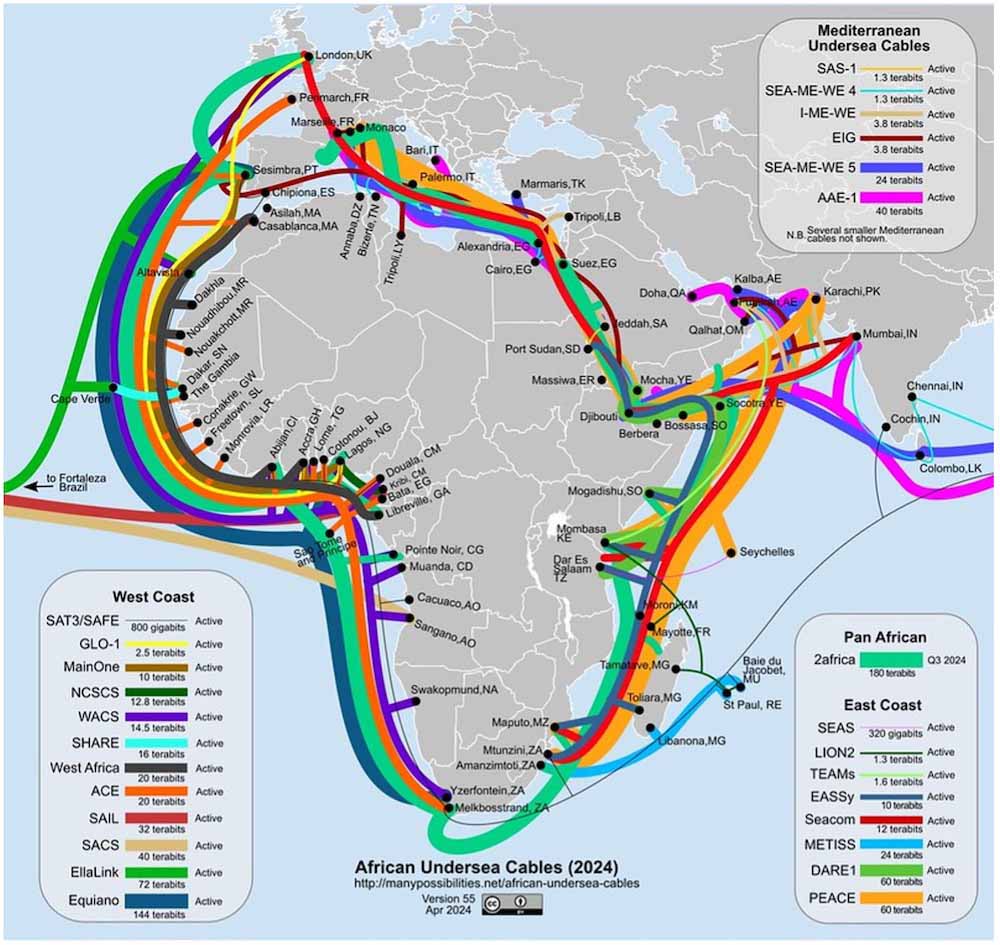
Figure 1 — African submarine cable map. Source: Many Possibilities
While these submarine cables predominantly benefit the countries that connect directly to them via coastal landing stations, neighboring landlocked countries also benefit via terrestrial cross-border fiber connections. For example, a terrestrial cross-border fiber cable connecting Kampala, Uganda, to the landing station in Mombasa, Kenya, delivers submarine capacity to Uganda, helping to reduce costs and latency.
Table 1 shows the submarine cables and terrestrial cross-border cables that provide connectivity to each country in the sub-region.
| Country | Submarine cables | Terrestrial cross border links to |
|---|---|---|
| Burundi | None | Democratic Republic of Congo, Rwanda, and Tanzania |
| Kenya | 2Africa, Africa-1, DARE-1,EASSy, LION2, PEACE, SEACOM, TEAMS | Ethiopia, Somalia, South Sudan, Tanzania and Uganda |
| Malawi | None | Mozambique, Tanzania, and Zambia |
| Mozambique | 2Africa, EASSy, SEACOM | Eswatini, Malawi, South Africa Tanzania, Zimbabwe, and Zambia |
| Rwanda | None | Burundi, Democratic Republic of Congo, Tanzania, and Uganda. |
| South Africa | ACE, EASSy, Equiano, METISS, SEACOM, SAFE, SAT-3, T3, WACS | Botswana, Eswatini, Lesotho, Namibia, Zimbabwe |
| Tanzania | EASSy, SEACOM, SEAS | Burundi, Democratic Republic of Congo, Kenya, Malawi, Mozambique, Rwanda, Uganda, and Zambia |
| Uganda | None | Democratic Republic of Congo, Kenya, Rwanda, Tanzania and South Sudan |
| Zimbabwe | None | Botswana, Mozambique, Namibia, South Africa and Zambia. |
Although it is difficult to measure the amount of traffic flowing along submarine and terrestrial cables—this information is contained in confidential agreements between ISPs—it’s estimated that 2,000 Gigabits per second (or two terabits per second) of traffic is exchanged within the sub-region (Figure 2).
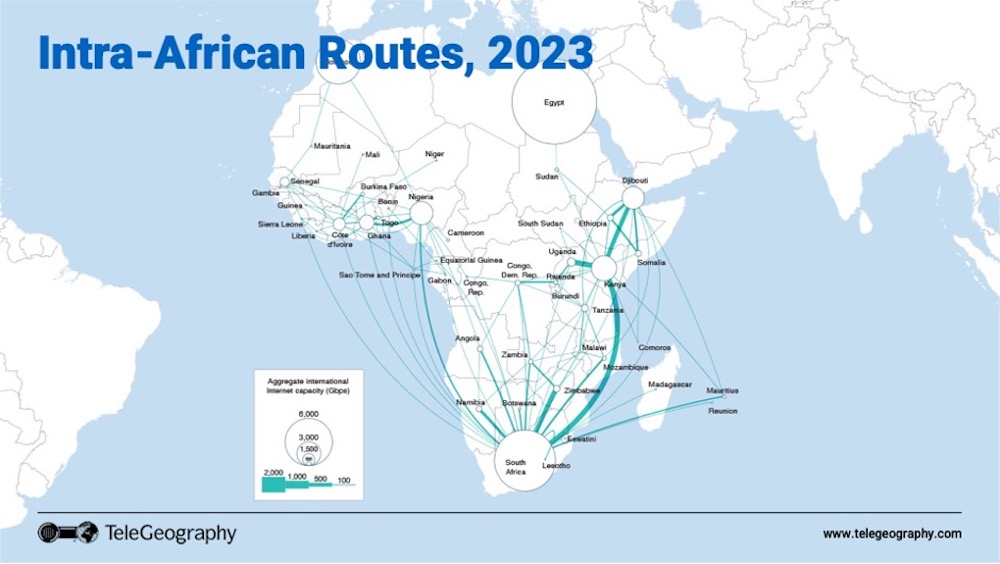
Figure 2 — Intra-African Routes, 2023. Source: Telegeography.
Ben Roberts, Group CTIO of Liquid Intelligent Technologies, notes that most of this traffic exchange is with South Africa, where several hyperscale cloud services are located.
South Africa has had announcements of hyperscale cloud instances that have already been launched. Kenya (and Nigeria) is yet to see hyperscale cloud but has a number of ‘edge pops’ and announcements of pending edge zones.”
Burundi, Malawi, Mozambique, Kenya, Rwanda, Tanzania, and Uganda rely predominantly on SEACOM and EASSy to access these hyperscale cloud services in South Africa and were, as such, the most affected countries during the outage.
Luckily, no country experienced a total Internet outage due to the availability of other operational submarine and cross-border terrestrial routes, Internet Exchange Points, and local content caches.
The Importance of IXPs
An IXP is a physical place, sometimes inside a data center, where different networks interconnect and send traffic to one another. This is known as peering and is part of what makes Internet services faster, more reliable, and cheaper.
Table 2 notes the number of IXPs in each country and the proportion of the local networks physically connected to IXPs in this country.
| Country | Number of IXPs | Proportion of the local networks directly connected at an IXP in this country |
|---|---|---|
| Burundi | 1 | 55.56% |
| Kenya | 8 | 30% |
| Malawi | 2 | 29.03% |
| Mozambique | 1 | 37.93% |
| Rwanda | 1 | 17.86% |
| South Africa | 10 | 54.02% |
| Tanzania | 6 | 29% |
| Uganda | 1 | 14.29% |
| Zimbabwe | 0 | N/A |
IXPs also provide insight into local traffic connectivity. The more networks connect at an IXP, the more insight an IXP has. The following graphs show the daily local Internet traffic being routed by IXPs in the Democratic Republic of Congo (GOMIX), Kenya (KIXP), Rwanda (RINEX), Tanzania (TIX), and Uganda (UIXP) in the lead-up to and following the 12 May cable outage and the impact that the cable outages had on normal traffic volumes.
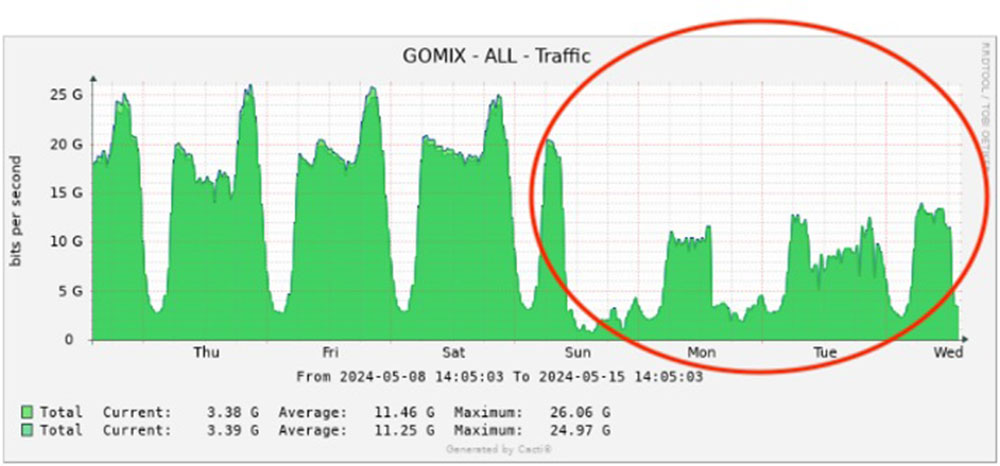
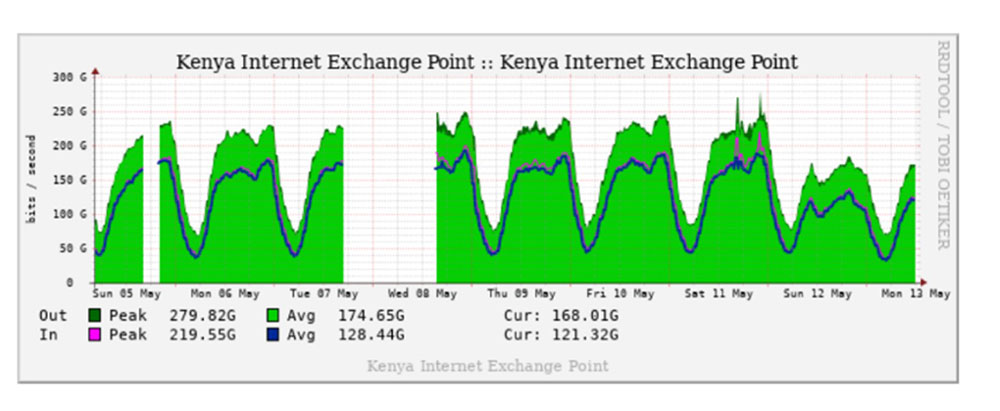
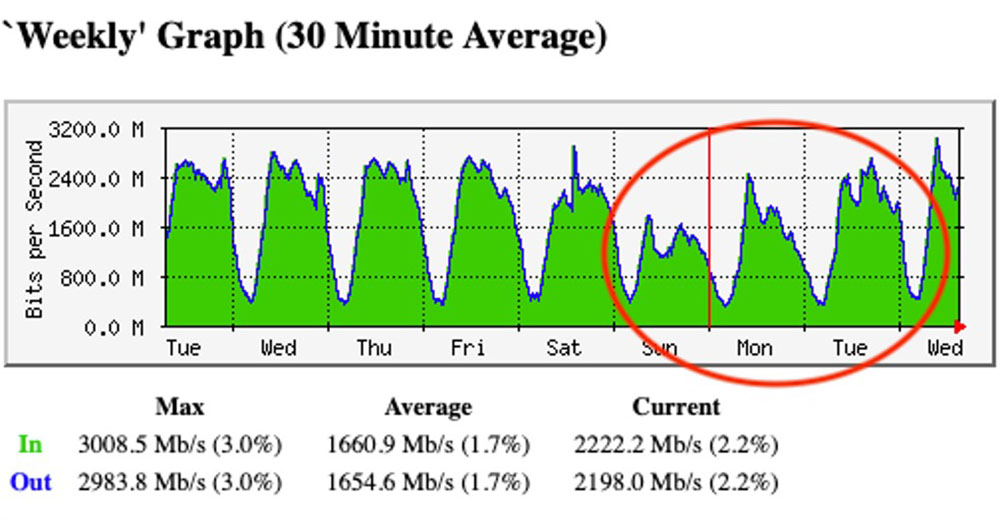
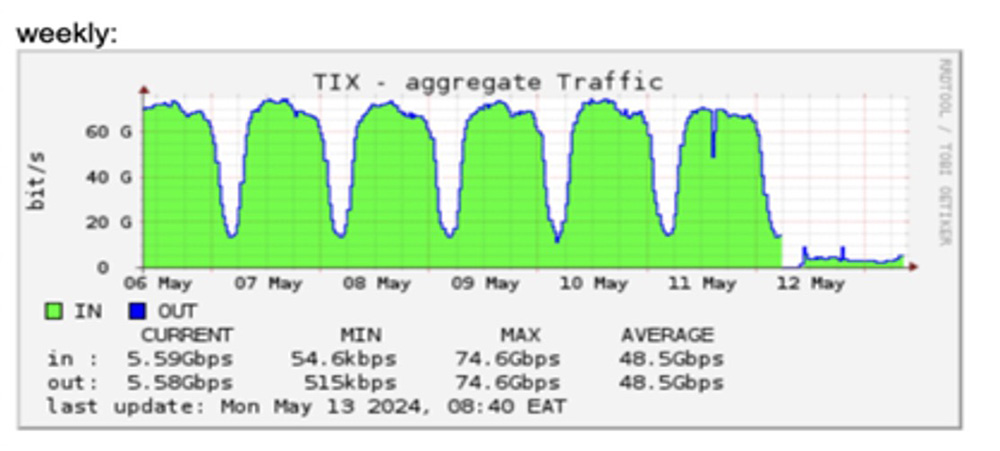
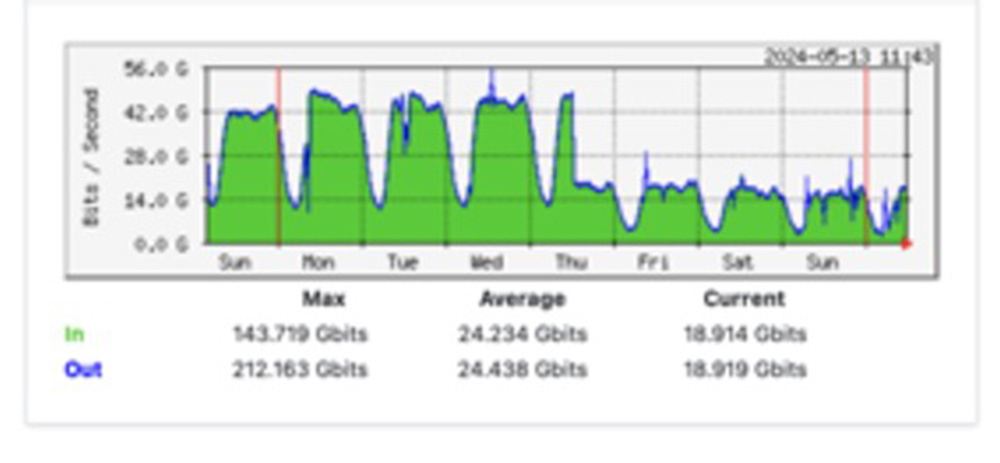
Figure 3 — From top to bottom, daily local Internet traffic being routed by IXPs in Democratic Republic of Congo (GOMIX), Kenya (KIXP), Rwanda (RINEX), Tanzania (TIX), and Uganda (UIXP) in the lead-up to and following the 12 May cable outage. The circle shows the impact of the outage.
In Rwanda, online or cloud-based (remotely accessed) services were majorly affected. However, RINEX (Rwanda’s IXP) statistics showed a mild drop in traffic compared to other IXPs in the subregion. In Tanzania, Uganda, Kenya, and the Democratic Republic of Congo, there were significant drops in traffic amounting to several Gigabits per second difference from normal patterns.
The Internet Society has carried out many activities to support the establishment and growth of IXPs in the countries affected by this outage. These activities have included training workshops, equipment donations, cache fill grants, and hosting peering forums to promote the local Internet ecosystem and strengthen the local technical community.
The Importance of Locally Available Content
IXPs also often host or provide access to Content Delivery Network (CDN) caching servers that serve popular traffic locally. Table 3 shows the percentage of the most popular 1,000 websites in each country that are hosted in-country, in-region, and out-of-region.
| Country | In Country | In Region | Out of Region |
|---|---|---|---|
| Burundi | 10.1% | 54.1% | 35.5% |
| Kenya | 60% | 14.8% | 25% |
| Malawi | 13.3% | 57.1% | 29.5% |
| Mozambique | 15.2% | 53.4% | 31% |
| Rwanda | 19.6% | 50.6% | 29.6% |
| South Africa | 86.1% | 0% | 13.7% |
| Tanzania | 24.9% | 48% | 26.9% |
| Uganda | 13.3% | 54.8% | 31.4% |
| Zimbabwe | 38.1% | 24.7% | 36.9% |
Cache servers require Internet connectivity to refresh content. When Internet connectivity is unavailable or of poor quality, fresh content cannot be downloaded by the servers, which then impacts what content can be made available to connecting networks.
Following the 12 May outage, Ugandan Internet Society Chapter member Lilian Achom reported having challenges accessing social media pages and e-learning resources. Nazarius, from our Tanzania Chapter, reported having severely degraded service for several hours.
Cloudflare and Kentik, both noted in their analyses of the outage that Tanzania experienced the greatest reduction in Internet performance.
The Importance of Redundancy and Cooperation
The Internet is designed so that when one route does not work, traffic can be automatically rerouted via another. The more routes to and from destinations, the greater the redundancy when one route is affected, and the less likely users will be affected or notice any performance issues.
Using BGPlay, we can playback the outage and see how traffic was re-routed for networks in Tanzania.
While IXPs and CDN caches help to offset the impact of international cable outages, the events of 12 May highlighted the level of international connectivity redundancy that countries have in the region. Traffic that was rerouted via other functioning submarine cables quickly congested these other routes, which were not ready or capable of carrying such loads.
In a show of industry collaboration, Liquid Intelligent Technologies and SEACOM worked together to provide alternative connectivity during the outage.
The Kenyan regulatory body—the Communication Authority—issued an X (formerly Twitter) update on 13 May on the situation and the use of the TEAMS cable for redundancy. Mobile network operators Safaricom and Airtel also issued updates indicating they had sought and activated alternative connectivity to maintain services during the outage.
These efforts are another example of the growing strength of the technical communitythat is supporting and developing the Internet in Africa.
The Path to Improved Internet Resilience
On 23 May, less than two weeks after the fiber cut, Google announced the development of a new terrestrial and submarine cable known as Umoja, which will be anchored in Kenya and pass through Uganda, Rwanda, the Democratic Republic of Congo, Zambia, Zimbabwe, and South Africa and also link Africa to Australia.
[Umoja] is a game changer for East Africa and will lower the latency of especially Uganda, Rwanda, and Eastern DRC, giving them direct access to important content in South Africa. This will dramatically improve the way we build our networks in Africa and reduce our reliance on subsea capacity for that important Intra Africa ‘Cape to Cairo’ connectivity that we have pioneered.”
The Umoja cable will add to other cables planned or in construction around Africa, including:
- 2Africa cable – which recently was partially activated with Airtel announcing the activating of a segment of the cable that will connect Kenya, Tanzania, and South Africa.
- Trans-Sahara Optical Fiber Backbone cable.
- The Djoliba cable.
These new cables may also encourage more hyperscale cloud providers and CDNs to establish points of presence and host content in more countries in the subregion, bringing content closer to users and thus making it cheaper and quicker to access. Recent growth in data center investment is a positive sign of infrastructure development that makes more local content available via IXPs.
IXPs will also continue to play a pivotal role in local traffic transit and are expected to see continued year-on-year growth in membership and traffic as Internet usage in East African countries continues to increase.
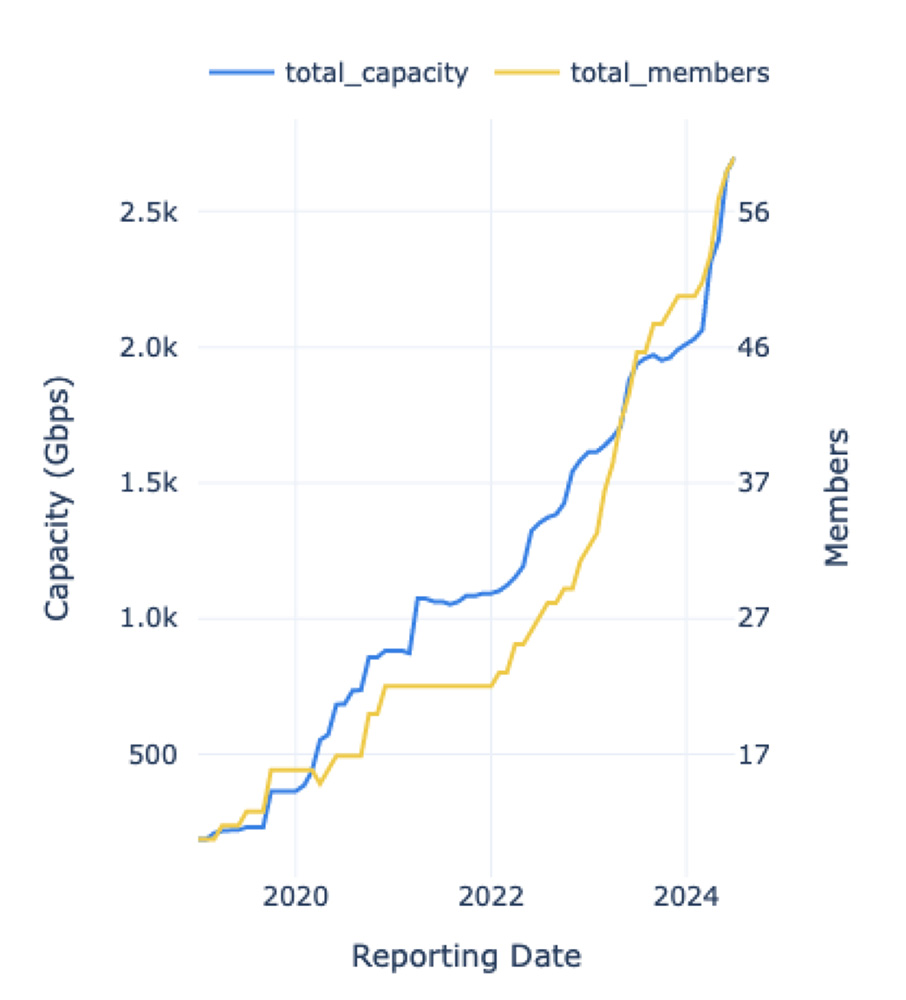
Figure 4—In the first half of 2024, traffic to IXPs in Kenya has increased by more than 25%. Source: Pulse IXP Tracker.
While these critical infrastructures are important to the overall performance of the Internet in any country, they are only two parts of a complex ecosystem that underpins the resilience of the Internet.
The Pulse Internet Resilience Index helps with understanding the various factors associated with the health and resilience of the Internet in more than 170 countries. Looking at the affected countries during this outage (Table 4), despite in some cases having a backup submarine cable and multiple IXPs, there is plenty of scope to improve their resilience so they can maintain a more acceptable level of service in the face of future faults.
| Country | Number of Submarine Cables | Number of IXPs | Internet Resilience Index (IRI) Score |
|---|---|---|---|
| Burundi | 0 | 1 | 27% |
| Kenya | 8 | 8 | 41% |
| Malawi | 0 | 2 | 29% |
| Mozambique | 3 | 1 | 30% |
| Rwanda | 0 | 1 | 49% |
| Tanzania | 3 | 6 | 38% |
| South Africa | 11 | 10 | 53% |
| Uganda | 0 | 1 | 42% |
| Zimbabwe | 0 | 0 | 31% |
All these efforts and the lessons learned from this and other large-scale outages validate the work that Internet Society has done and will continue to do to continue to increase the resilience of the Internet and empower those who defend and grow the Internet in all countries worldwide.
